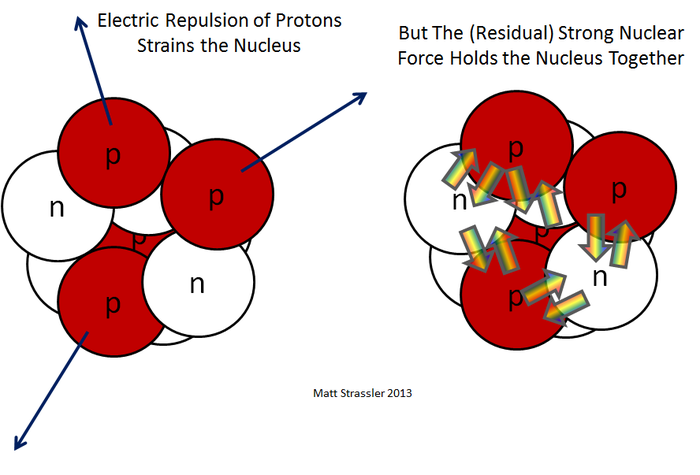The strong nuclear force is a fundamental interaction that plays a pivotal role in governing the behavior of subatomic particles. As the force responsible for holding protons and neutrons together within atomic nuclei, it endows matter with stability and structure. This enigmatic force, while extraordinarily potent at short ranges, has a functional form that elucidates its nature and characteristics. In this article, we will delve deeply into the functional form of the strong nuclear force, exploring its mathematical representations, implications, and the broader questions it raises in the realm of particle physics.
The strong nuclear force exhibits a unique functional form primarily described by the theory of quantum chromodynamics (QCD). This theory posits that the fundamental constituents of protons and neutrons—quarks—are held together by the exchange of gluons, the force carriers of the strong interaction. The interaction can be succinctly encapsulated through the potential energy model often represented as a combination of a short-range attractive potential and a long-range repulsive force, depicted in many theoretical models as an intricate function of distance. Understanding this functional form can elucidate why the strong nuclear force is characterized by both its range and its potency.
Classically, the potential energy of the strong force can be represented using a form analogous to the Yukawa potential, which embodies a significant component of its short-range nature. The Yukawa potential is expressed as:
V(r) = -g² * e^(-μr) / r
In this equation, the variable r denotes the distance between nucleons, g represents the coupling constant indicative of the strength of the interaction, and μ correlates to the mass of the exchanged particle, specifically a meson in the context of nuclear forces. The exponential term elucidates the damping of the force’s influence as distance increases, exhibiting that the strong force is attractive at short distances but diminishes quickly. The Yukawa potential’s decay epitomizes the short-range confinement of the strong force, which operates effectively at distances on the order of one femtometer (10^-15 meters).
However, this representation is only partially adequate, especially at scales beyond a single nucleus. As one delves deeper into the realm of QCD, it becomes evident that the strong force exhibits a phenomenon called “asymptotic freedom,” wherein quarks experience reduced interaction strength at exceedingly short distances. This counterintuitive behavior provokes fascination and signifies the complexity of the strong force’s functional form. Furthermore, as the distance between quarks increases, the force strengthens, leading to confinement—a manifestation of color charge dynamics that traps quarks within protons and neutrons, thereby precluding isolation.
In addition to the Yukawa potential, a clearer qualitative understanding emerges when examining the lattice QCD framework, which utilizes a discretized space-time lattice to model interactions between quarks and gluons. By leveraging numerical simulations, researchers have unveiled the nature of the strong force as being non-linear and dependent on gluon interactions. This non-abelian property, unlike electromagnetism, reveals that the strong force does not simply weaken as distance increases but instead becomes increasingly robust, forming a confining potential that dwarfs the simplicity of the Yukawa potential.
The confining potential, at longer ranges, can often be modeled with a linear potential:
V(r) = σr
In this expression, σ signifies the string tension, qualitatively describing energy per unit length associated with the quark-antiquark pairs that manifest as confinement forces. This linear behavior encapsulates the intuition that as two quarks are separated, the energy input required to separate them increases without bounds—leading to the creation of additional quark-antiquark pairs before isolation can take place.
The juxtaposition of the Yukawa and linear potential underscores the dual nature of the strong force, transitioning from one governing behavior to another as interaction distances fluctuate. This complex portrait not only addresses core atomic stability but also prompts questions about the fundamental interactions of the universe. What are the implications of such forces on larger astrophysical structures? How do they shape the universe at its most fundamental levels?
Furthermore, the intrinsic symmetry properties of the strong force, notably its gauge invariance, forge connections to broader aspects of theoretical physics, including the search for a grand unified theory. In essence, the functional form of the strong nuclear force encapsulates profound truths about particle dynamics, structure formation, and the underlying principles that manifest in the cosmos.
In conclusion, the functional form of the strong nuclear force—a captivating amalgamation of both Yukawa and linear representations—serves as a gateway to understanding not only the interactions within the atomic nucleus but also the very fabric of quantum field theory. Its study unveils layers of complexity that intrigue physicists and continue to inspire research into the mysteries of matter and the universe itself. The strong nuclear force, in its myriad forms, remains a testament to the elegance of nature’s fundamental laws.












